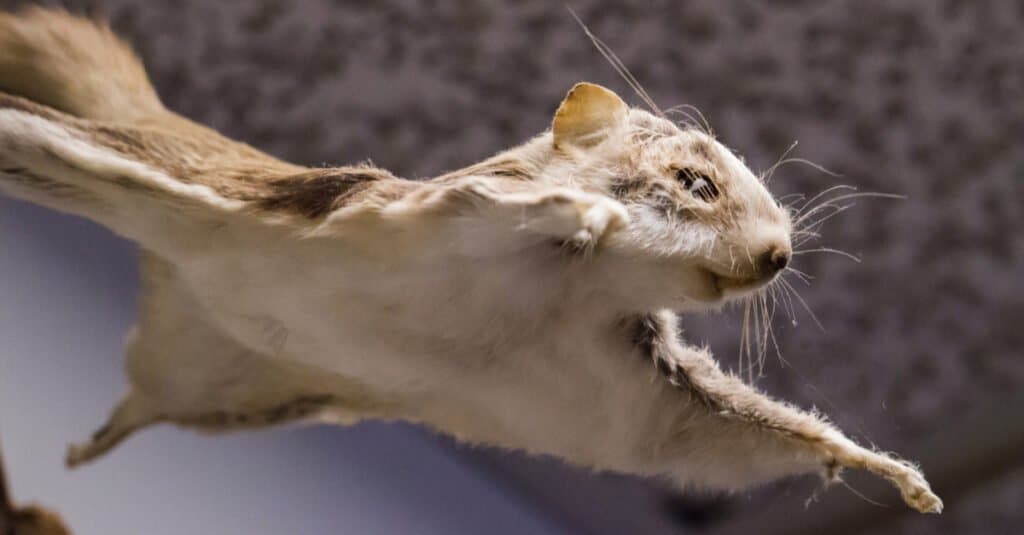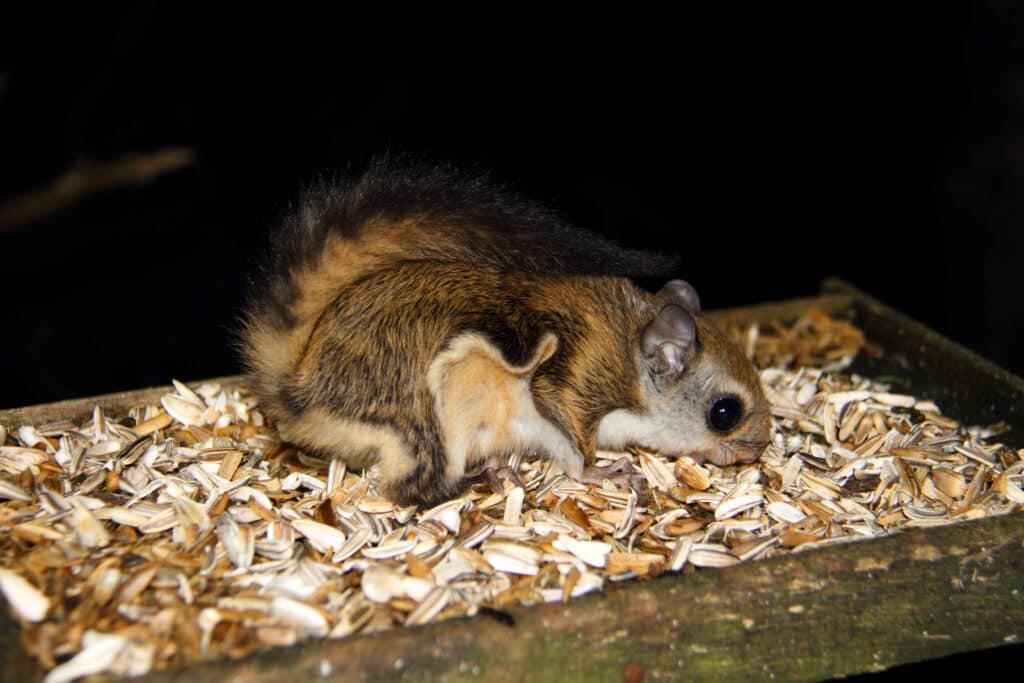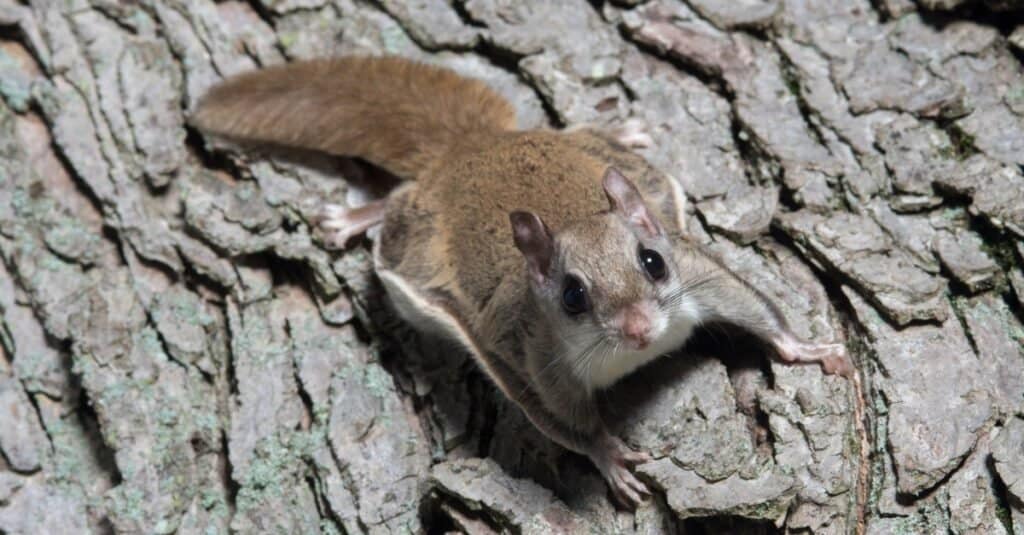Flying squirrels live in various environments and climates across several continents. They nest in trees, rock crevices, cave ledges, and even in attics if they live nearby human settlements. These furry mammals are adaptable and have ways to survive harsh winters and see at night. But are they active during the day or the nighttime? This article explores the sleep behavior of flying squirrels and discusses whether they are nocturnal or diurnal.
Flying Squirrels are Nocturnal

Despite being nocturnal, flying squirrels adapt their activity to the changes in their environmental temperatures and lengths of the evenings.
©Laura Fiorillo/Shutterstock.com
Flying squirrels are nocturnal mammals that sleep during the day and hunt at night. Their nighttime activity differs with the seasons and light/dark periods. In the winter, the dark periods are longer, lasting roughly 16 hours. At this stage, flying squirrels only leave their nests for approximately three to nine hours.
During this time, they switch between leaving their nests frequently throughout the night to forage and returning to rest. They sleep in their nests in groups during the winter, huddling together to conserve heat and energy. This activity differs from the warmer months when the flying squirrels are more active.
Flying squirrels in the northern regions experience the White Night between May and July, the warmer months. The White Night is the name of the phenomenon when the sun does not fully set but instead drops to only six degrees above the horizon. The night glows as it is never entirely dark during the White Night phenomenon. Additionally, during the White Night, flying squirrels become active just after sunset until just before dawn.
Flying Squirrels have Nocturnal Vision
Flying squirrels have large eyes that allow for excellent night vision. Larger eyes in mammals mostly means more light can enter them, improving their night vision. Their retinas contain structures known as cones and rods, with many more rods than cone-like receptors. More rods in a retina mean the animal can see better in low light conditions. Squirrels have a rod density of between 10% and 40%. But flying squirrels have a rod density of almost 100%, meaning they have excellent night vision.
Scientists also found that flying squirrels have a duplication of functions in their visual system. Scientists discovered this feature by observing an electroretinogram (ERG) of their eyes, the isolated PIII retinal response, and the visually evoked cortical potential (VECP). Their two visual functions also have different spectral sensitivities. All this means is that flying squirrels have superior night vision, allowing them to navigate their environments easily.
They Enter the Torpor State in Winter

Flying squirrels do not hibernate but enter a state of torpor during winter.
©feathercollector/Shutterstock.com
Flying squirrels live in icy and cold environments across Canada, Finland, and Siberia but do not hibernate despite this cold. Instead, the little nocturnal flying squirrel enters a state of torpor. The state of torpor refers to reduced metabolic rate and body temperature. When an animal enters this state, it does so to conserve energy and heat with the other flying squirrels in the nest.
The average body temperature of a flying squirrel is 102 degrees Fahrenheit, but this will subside to between 70 and 85 degrees Fahrenheit. Flying squirrels enter a state of inertia following severe temperature drops as they cannot find food due to the harsh weather.
However, they do wake from their torpor intermittently. An observation conducted in the winter of 1951 proved this. People took a tree down, only to find it housed the nest of three flying squirrels. After the tree hit the ground and broke the nest, the flying squirrels were found alive but curled up and still sleeping. They only woke after being handled for a few minutes. These mammals survive the harsh winters by crowding together in one nest. Flying squirrels share their nests with other creatures, like bats and owls.
Flying Squirrels do not only Nest in Trees
There are 43 different nocturnal species of flying squirrels and they live in northern Eurasia, in North America from Mexico up to Canada, and in Central Africa. Flying squirrels have adapted to their diverse habitats with varying temperate, tropical, and arctic conditions. These little mammals build their nests in many locations, including trees, rock crevices, and cave ledges in the wild.
The nests are usually 50 to 60 feet from the ground, and they live this high to avoid predators at ground level. Flying squirrels typically build their nests using leaves, shredded bark, moss, and lichen. But due to habitat loss, they have had to adapt to human environments, so now they also seek refuge in roofs and attics. Flying squirrels nesting in an attic can become a problem for the homeowner, as their occupation can quickly develop into an infestation.
Flying Squirrel Nighttime Activity

Most flying squirrels come out to forage during the night.
©iStock.com/EEI_Tony
These nocturnal animals come out of their nests at night to look for food. Most species prefer to stay off the ground when foraging, but some will descend to the earth if necessary. Flying squirrel diets typically comprise nuts, seeds, mushrooms, and fruit like pin cherries, juneberries, huckleberries, and mountain ash.
These nocturnal flying squirrels travel not by flying as their name suggests but by volplaning. They climb to a point and then leap into the air with their patagium outstretched. The patagium is the body part consisting of the skin folds between the legs. The patagium allows them to glide in a descending curve. Flying squirrels glide as far as 150 feet to travel to other trees and escape predators.
These Frequent Flyers Glow Pink Under Ultraviolet Light
Their fur glows pink if you shine an ultraviolet light on a flying squirrel. Their undersides glow stronger than their topsides, but the reason for this glow is not fully known. However, researchers theorize that nocturnal flying squirrels glow under ultraviolet light to avoid predators, communicate with other flying squirrels, or navigate in snowy and icy environments.
Nocturnal vs. Diurnal: What’s The Difference?
Navigate to Nocturnal vs. Diurnal: What’s The Difference? for further information about the nocturnal and diurnal phenomenon in various living creatures.
Up Next
- 10 Incredible Flying Squirrel Facts
- Flying Squirrel vs Sugar Glider: What Are The Differences?
- What Do Flying Squirrels Eat? 13 Foods for This Cute Rodent
The photo featured at the top of this post is © Laura Fiorillo/Shutterstock.com
Sources
- Springer, Available here: https://link.springer.com/article/10.1007/BF00663431
- Web Archive, Available here: https://web.archive.org/web/20200320110913id_/http:/zmmu.msu.ru/rjt/articles/ther2_2_105_113_Fokin.pdf
Thank you for reading! Have some feedback for us? Contact the AZ Animals editorial team.






